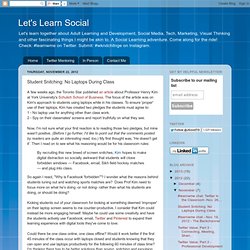

Jane’s Pick: Top 50 Articles of 2012. EmailShare 0EmailShare For the last 4 years I have produced a Top 100 Articles of the year list containing the resources I particularly enjoyed during the year.

However, this year as I’ve been doing a Pick of the Month, I’ve decided to keep the list to just 50 key articles. Performance support “hearts” training and vice versa. In September I attended the eLearning Guild’s new conference, Performance Support Symposium.

Ontuitive’s Bob Mosher kicked it off with a mighty bang, offering the jaw-dropping suggestion that we cast off training in favor of performance support. Like Bob, I am hooked on performance support. In the 80s, I wrote a book about job aids. More recently, I wrote another, this one called Handbook for Job Aids and Performance Support . ELC 002: Using Social Media For Learning. Hi Connie!

Listening to Jane talking about using the social media for learning got me thinking… i do a lot of classroom training on Oracle Siebel CRM. Most of the topics are very technical, e.g. how to configure the software. I am going to suggest – to the management – to do a pilot for the upcoming class. Almost every college graduate in India these days has a cellphone and are on FB. These are the people who join my company (wipro Ltd.) and go thru 45 days of extensive training (Project Readiness Program, PRP). DePaul_Informal_Learning_022912.gif (1500×1163) Informal-learning.jpg (8000×3000) Quick start guide to flipping your classroom using screencasting or lecture videos. On Your Mark, Get Set, FLIP!

Are you thinking about flipping your classroom? There are lots of different, interesting ways to flip a class. One popular, entry-level approach to flipped teaching is to deliver direct instruction (i.e. lectures) outside of class, using pre-recorded videos covering content. Instructors then spend class time on activities that students would normally do at home, such as homework problems. Flipped experts Bergmann and Sams call this the “flipped 101″ approach, emphasizing that there is more than one way to flip a class and putting videos online and doing homework in class is one of the most basic of those ways.
For videos in a flipped 101 approach, some instructors select pre-existing content that others have created to use as direct instruction. Ready? Keep these prep steps in mind as you get ready to flip your classroom. Quick Start Guide (Download a PDF of the guide here) Nstant learning is a key theme in the Future of Work.
The future belongs to those who take charge of their own learning. Once upon a time (as all good fairy tales start) employees had a job for life.

Having left school or college you could start work for an organization and remain there for your whole professional life. The company would provide you with all the training you needed, give you all the promotions you deserved and then at your retirement, reward your long service with the gift of a clock or a gold watch. What is Social Learning ? The Million dollar question … Why Social Learning Benefits Your Business. This post originally appeared on the American Express OPEN Forum, where Mashable regularly contributes articles about leveraging social media and technology in small business.

Classroom training isn’t dead, but it also isn’t the answer for every training need. Social tools are changing the game when it comes to employee learning. Organizations can create collaborative workplaces where employees can learn from each other instead of only learning in a formal setting or from the proverbial "company expert. " For training programs to be effective, companies must use the right methods and medium for their training sessions and their audience. Given the popularity of social media, it only seems logical to explore how social media tools can have a positive impact on the learning experience. Content Curation. Emerging new roles for learning and performance professionals. Dear CSTD…why you should stop talking about Learning Styles « The Hitch Hiker's Guide to Learning.
While this response is directed to the good folks at CSTD, I leave it as a public artifact for those interested in the whole Learning Styles thing.

There was a time when I admit that I subscribed to the concept of Learning Styles. I also understand why there’s an instinctive sense-making and buy-in when people look at it. Whether you subscribe to Kolb (1984) or to the VAK theory, we generally accept that people tend to learn in different ways. Yes. But… Where things tend to go awry is that many L&D professionals (who should know better) and other people who think they know enough about learning, is that a) the styles are taken as absolutes; and, b) that there is an assumed link from learning styles to teaching styles. Let’s deal with the first bit.
Kolb’s Experiential Learning Cycle, with the identification of 4 kinds of Learning. James offers one of the best quotes about Learning Styles by saying: Curious about the potential change, I did a little experiment. Nope. Wrong. Right.
Student Snitching: No Laptops During Class. A few weeks ago, the Toronto Star published an article about Professor Henry Kim at York University's Schulich School of Business.

The focus of the article was on Kim's approach to students using laptops while in his classes. To ensure 'proper' use of their laptops, Kim has created two pledges the students must agree to: 1 - No laptop use for anything other than class work. 2 - Spy on their classmates' screens and report truthfully on what they see. Now, I'm not sure what your first reaction is to reading those two pledges, but mine wasn't positive. (Before I go further, I'd like to point out that the comments posted by readers are quite an interesting read, too.) My first thought was, 'He doesn't get it'. By recruiting this new breed of screen snitches, Kim hopes to make digital distraction so socially awkward that students will close forbidden windows — Facebook, email, Sikh field hockey matches — and plug into class.
30 Ideas To Promote Creativity In Learning. 30 Ideas To Promote Creativity In Learning by Miriam Clifford, opencolleges.edu.au This post has been republished from a 2012 post.

The concept of teaching creativity has been around for quite some time. Academics such as E. Paul Torrance, dedicated an entire lifetime to the advancement of creativity in education. In recent times, there has been a shift towards the increased acceptance of valuing creativity for all learners. Inspire Teachers.
York University prof enlists student snitches to battle digital distraction. When professor Henry Kim noticed a student this week paying more attention to his laptop than the class discussion, he asked another student to check out the suspect’s screen.

The business professor at York University’s Schulich School of Business quietly asked the tweeter to leave for the rest of the 90-minute class for breaking the pledge his students must take not to use laptops for anything but class work. And it meant using another new pledge this frustrated teacher had students take this fall; to spy on a classmate’s screen, if asked, and report truthfully what they see. York University prof enlists student snitches to battle digital distraction.